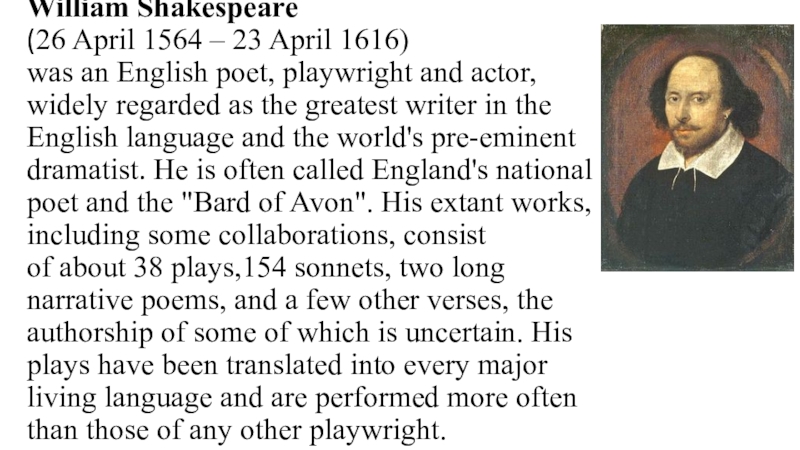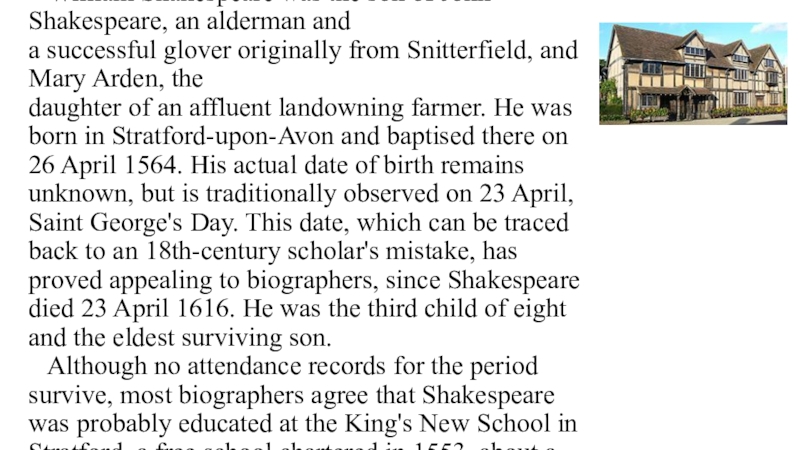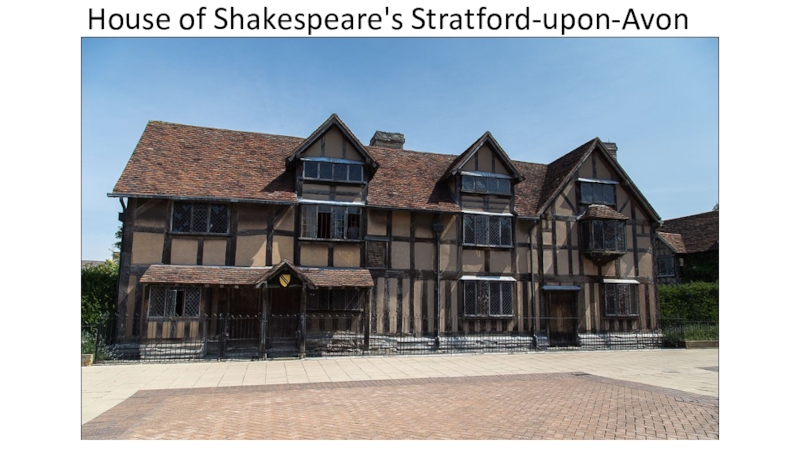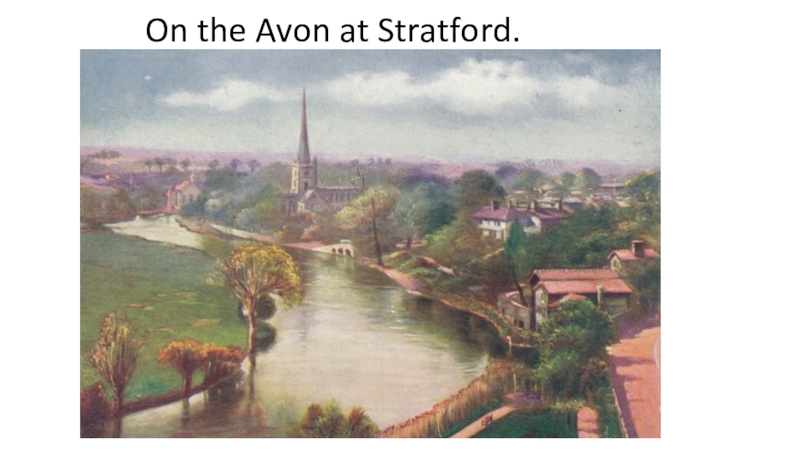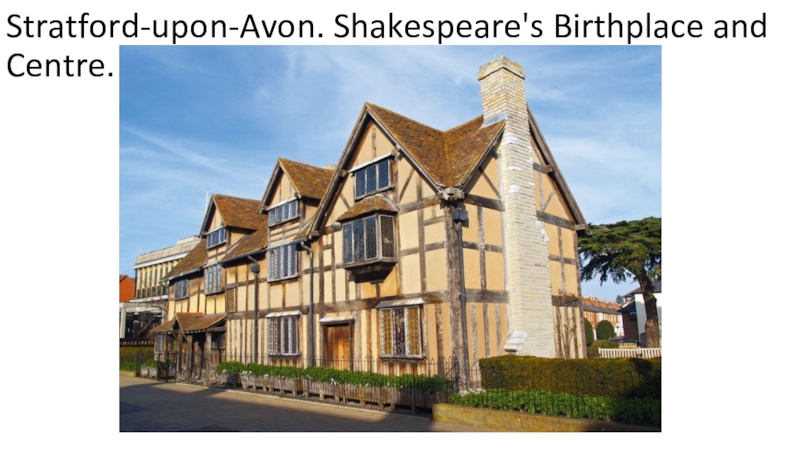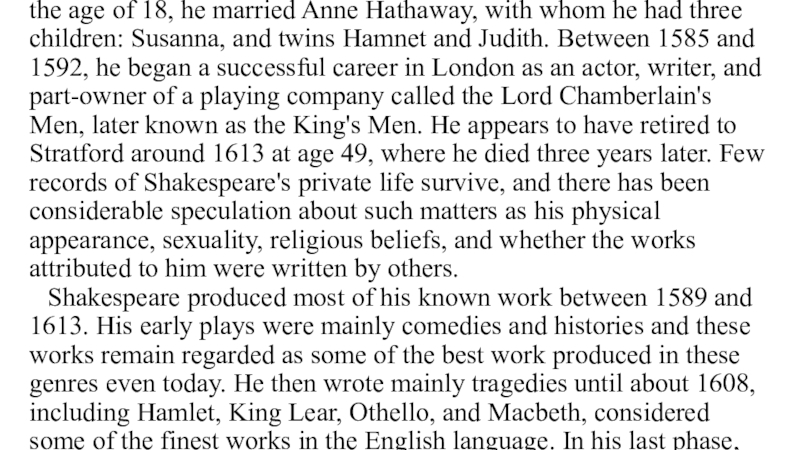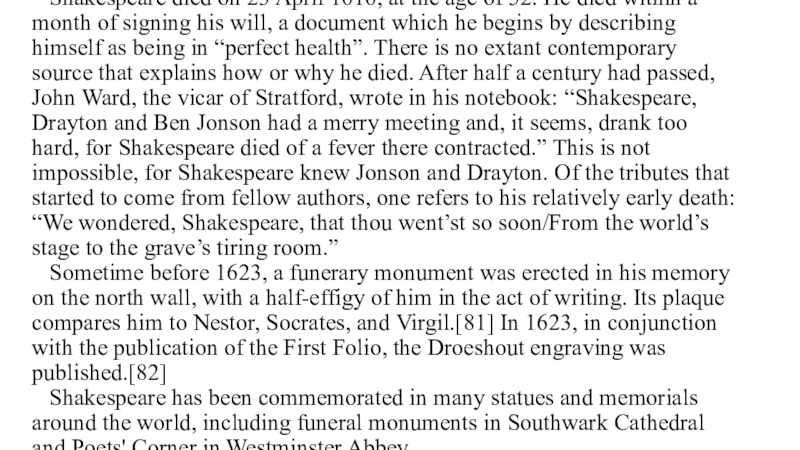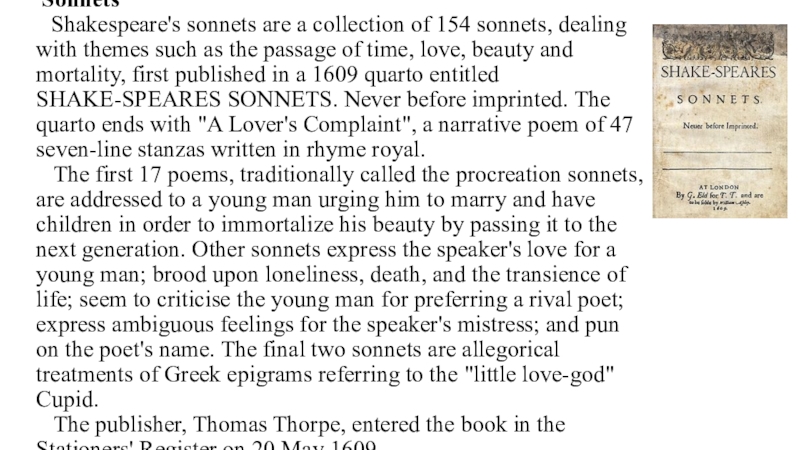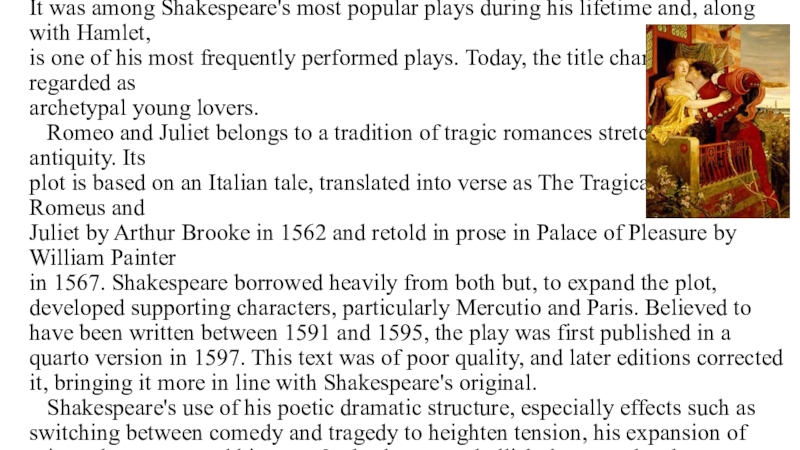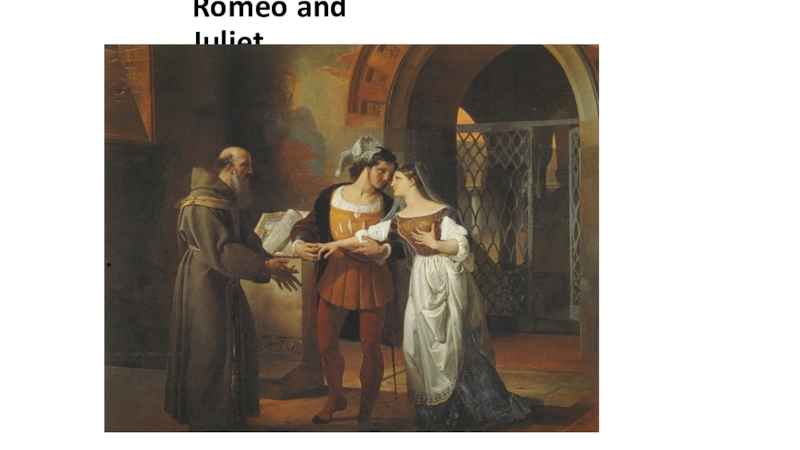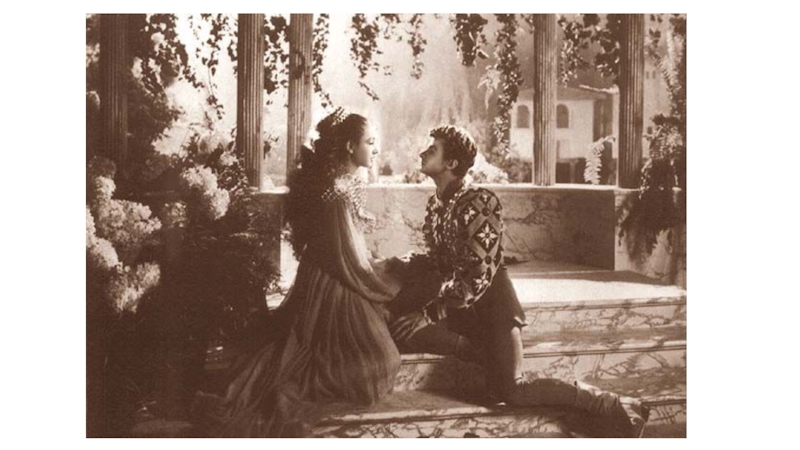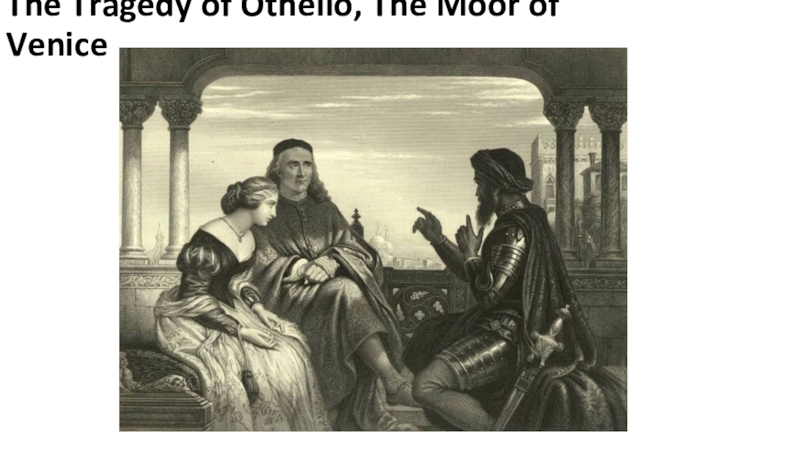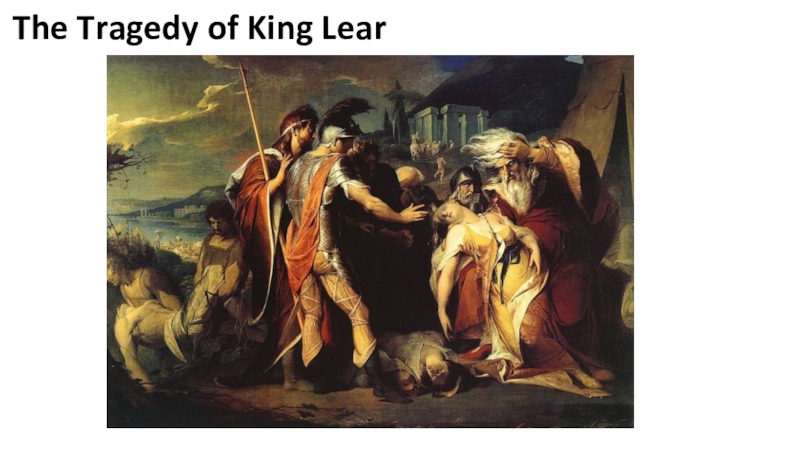Shakespeare’s Land
William Shakespeare
(26 April 1564 – 23 April 1616)
was an English poet, playwright and actor, widely regarded as the greatest writer in the English language and the world's pre-eminent dramatist. He is often called England's national poet and the "Bard of Avon". His extant works, including some collaborations, consist
of about 38 plays,154 sonnets, two long narrative poems, and a few other verses, the authorship of some of which is uncertain. His plays have been translated into every major living language and are performed more often than those of any other playwright.
- Главная
- Разное
- Образование
- Спорт
- Естествознание
- Природоведение
- Религиоведение
- Французский язык
- Черчение
- Английский язык
- Астрономия
- Алгебра
- Биология
- География
- Геометрия
- Детские презентации
- Информатика
- История
- Литература
- Математика
- Музыка
- МХК
- Немецкий язык
- ОБЖ
- Обществознание
- Окружающий мир
- Педагогика
- Русский язык
- Технология
- Физика
- Философия
- Химия
- Шаблоны, фоны, картинки для презентаций
- Экология
- Экономика
Презентация, доклад по английскому языку на тему William Shakespeare
Содержание
- 1. Презентация по английскому языку на тему William Shakespeare
- 2. Shakespeare's Globe Portrait William Shakespeare
- 3. Early life
- 4. House of Shakespeare's Stratford-upon-Avon
- 5. Shakespeare Monument Family William Shakespeare in New York, Central Park
- 6. On the Avon at Stratford.
- 7. Stratford-upon-Avon. Shakespeare's Birthplace and Centre.
- 8. The Gower Memorial to Shakespeare.
- 9. Death Shakespeare was born and
- 10. Shakespeare died on 23 April
- 11. The tomb of William Shakespeare
- 12. Sonnets Shakespeare's sonnets are
- 13. Romeo and Juliet is a
- 14. Romeo and Juliet
- 15. Слайд 15
- 16. The Tragedy of Hamlet, Prince
- 17. The Tragedy of Othello, The Moor of Venice
- 18. The Tragedy of King Lear
Shakespeare's Globe Portrait William Shakespeare
Слайд 3 Early life William Shakespeare was the son
of John Shakespeare, an alderman and
a successful glover originally from Snitterfield, and Mary Arden, the
daughter of an affluent landowning farmer. He was born in Stratford-upon-Avon and baptised there on 26 April 1564. His actual date of birth remains unknown, but is traditionally observed on 23 April, Saint George's Day. This date, which can be traced back to an 18th-century scholar's mistake, has proved appealing to biographers, since Shakespeare died 23 April 1616. He was the third child of eight and the eldest surviving son.
Although no attendance records for the period survive, most biographers agree that Shakespeare was probably educated at the King's New School in Stratford, a free school chartered in 1553, about a quarter-mile from his home.
Слайд 9Death Shakespeare was born and brought up in Stratford-upon-Avon. At
the age of 18, he married Anne Hathaway, with whom he had three children: Susanna, and twins Hamnet and Judith. Between 1585 and 1592, he began a successful career in London as an actor, writer, and part-owner of a playing company called the Lord Chamberlain's Men, later known as the King's Men. He appears to have retired to Stratford around 1613 at age 49, where he died three years later. Few records of Shakespeare's private life survive, and there has been considerable speculation about such matters as his physical appearance, sexuality, religious beliefs, and whether the works attributed to him were written by others.
Shakespeare produced most of his known work between 1589 and 1613. His early plays were mainly comedies and histories and these works remain regarded as some of the best work produced in these genres even today. He then wrote mainly tragedies until about 1608, including Hamlet, King Lear, Othello, and Macbeth, considered some of the finest works in the English language. In his last phase, he wrote tragicomedies, also known as romances, and collaborated with other playwrights.
Слайд 10 Shakespeare died on 23 April 1616, at the age
of 52. He died within a month of signing his will, a document which he begins by describing himself as being in “perfect health”. There is no extant contemporary source that explains how or why he died. After half a century had passed, John Ward, the vicar of Stratford, wrote in his notebook: “Shakespeare, Drayton and Ben Jonson had a merry meeting and, it seems, drank too hard, for Shakespeare died of a fever there contracted.” This is not impossible, for Shakespeare knew Jonson and Drayton. Of the tributes that started to come from fellow authors, one refers to his relatively early death: “We wondered, Shakespeare, that thou went’st so soon/From the world’s stage to the grave’s tiring room.”
Sometime before 1623, a funerary monument was erected in his memory on the north wall, with a half-effigy of him in the act of writing. Its plaque compares him to Nestor, Socrates, and Virgil.[81] In 1623, in conjunction with the publication of the First Folio, the Droeshout engraving was published.[82]
Shakespeare has been commemorated in many statues and memorials around the world, including funeral monuments in Southwark Cathedral and Poets' Corner in Westminster Abbey.
Слайд 12 Sonnets Shakespeare's sonnets are a collection of 154 sonnets,
dealing with themes such as the passage of time, love, beauty and mortality, first published in a 1609 quarto entitled SHAKE-SPEARES SONNETS. Never before imprinted. The quarto ends with "A Lover's Complaint", a narrative poem of 47 seven-line stanzas written in rhyme royal.
The first 17 poems, traditionally called the procreation sonnets, are addressed to a young man urging him to marry and have children in order to immortalize his beauty by passing it to the next generation. Other sonnets express the speaker's love for a young man; brood upon loneliness, death, and the transience of life; seem to criticise the young man for preferring a rival poet; express ambiguous feelings for the speaker's mistress; and pun on the poet's name. The final two sonnets are allegorical treatments of Greek epigrams referring to the "little love-god" Cupid.
The publisher, Thomas Thorpe, entered the book in the Stationers' Register on 20 May 1609.
Слайд 13 Romeo and Juliet is a tragedy written by William
Shakespeare early in his career about
two young star-crossed lovers whose deaths ultimately reconcile their feuding families.
It was among Shakespeare's most popular plays during his lifetime and, along with Hamlet,
is one of his most frequently performed plays. Today, the title characters are regarded as
archetypal young lovers.
Romeo and Juliet belongs to a tradition of tragic romances stretching back to antiquity. Its
plot is based on an Italian tale, translated into verse as The Tragical History of Romeus and
Juliet by Arthur Brooke in 1562 and retold in prose in Palace of Pleasure by William Painter
in 1567. Shakespeare borrowed heavily from both but, to expand the plot, developed supporting characters, particularly Mercutio and Paris. Believed to have been written between 1591 and 1595, the play was first published in a quarto version in 1597. This text was of poor quality, and later editions corrected it, bringing it more in line with Shakespeare's original.
Shakespeare's use of his poetic dramatic structure, especially effects such as switching between comedy and tragedy to heighten tension, his expansion of minor characters, and his use of sub-plots to embellish the story, has been praised as an early sign of his dramatic skill. The play ascribes different poetic forms to different characters, sometimes changing the form as the character develops. Romeo, for example, grows more adept at the sonnet over the course of the play.
Слайд 16 The Tragedy of Hamlet, Prince of Denmark, often shortened
to Hamlet, is a tragedy written by William Shakespeare at an uncertain date between 1599 and 1602. Set in the Kingdom of Denmark, the play dramatises the revenge Prince Hamlet is instructed to enact on his uncle Claudius. Claudius had murdered his own brother, Hamlet's father King Hamlet, and subsequently seized the throne, marrying his deceased brother's widow, Hamlet's mother Gertrude.
Hamlet is Shakespeare's longest play and among the most powerful and influential tragedies in English literature, with a story capable of "seemingly endless retelling and adaptation by others." The play seems to have been one of Shakespeare's most popular works during his lifetime and still ranks among his most-performed, topping the performance list of the Royal Shakespeare Company and its predecessors in Stratford-upon-Avon since 1879. It has inspired writers from Goethe and Dickens to Joyce and Murdoch, and has been described as "the world's most filmed story after Cinderella".
